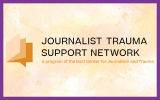Resources for Training
The Dart Center at the Double Exposure Investigative Film Festival and Symposium

How Can Indigenous Reporters Care for Themselves While Covering Trauma — and How Can Their Newsrooms Help?
In the last months, the remains of over a thousand people, including at least hundreds of Indigenous children, have been discovered on the properties of former residential schools in British Columbia and Saskatchewan. These discoveries have brought to the fore — for now — a subject that has long remained at the margins of mainstream media coverage in the United States: the genocide of millions of Indigenous people by colonizers.

Dart Center Style Guide for Trauma-Informed Journalism
This Dart Center style guide is designed as a quick, authoritative reference for reporters, editors and producers working on tight deadlines. It includes brief evidence-informed guidance on news choices, language usage and ethics in reporting on the impact of trauma on individuals, families and communities; recommendations for appropriate use of relevant psychological and scientific terminology; and special considerations when reporting on consequential trauma-laden issues such as racism and sexual violence.

Dart launches clinician training program to support trauma-exposed journalists
To aid journalists challenged by covering violence, crisis and tragedy, the Dart Center for Journalism and Trauma is launching an innovative training program preparing psychologists to work effectively with news professionals.
Staying Resilient While Managing Threat and Trauma
Free Training Webinar: Covering Riots and Civil Unrest

Call for Applications: Reporting on Refugees and Migration Through the Eyes of Children
The Dart Center is hosting a four-day journalism training workshop focused on children and the international refugee crisis.

Op-Ed: "Our Role is to Campaign" DCAP Hosts Retreat for Aboriginal Journalists
Amy McQuire reflects on a Dart Centre Asia Pacific retreat focussed on Indigenous trauma reporting, and explains why she believes Aboriginal journalists need to embrace an advocate's role.